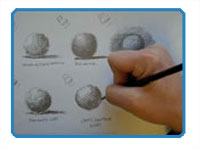
By Matt Fussell
Graphite drawing techniques are virtually endless. Anyway that you choose to apply graphite to a surface will produce some sort of results. A few techniques are commonly used and that is what this page is focused on.
The first graphite drawing technique is "hatching and crosshatching". This technique can be used with a variety of drawing media besides graphite. Hatching and crosshatching is achieved by drawing lines to create value. These lines may cross over each other. The more the lines cross over each other, the darker the value. By varying the frequency of marks, a range of value can be achieved. This range of value leads to the illusion of form.
The second graphite drawing technique is called "blending". Blending can take on many forms. Some artists prefer to vary the amount of pressure put on the pencil to change the amount of material applied. This creates the range of value that is necessary for the illusion of form. Some artists use their fingers to blend the graphite after it is applied to the surface. I highly discourage this technique. You have more control with the pencil that you do with your fingers. Also, your fingers add oils to the graphite, which usually results in messy artwork. Instead, you should smear the graphite with a blending stump seen in the video below. It allows you to smoothly blend the value of the graphite, while keeping full control over the medium.
The third graphite drawing technique is "rendering". Rendering occurs when you use an eraser to draw. This usually means that the artist applies graphite to the surface and then removes some it. It is a process of addition and subtraction of the graphite from the surface. Rendering usually results in a "smokey", atmospheric look.
The fourth most commonly used graphite drawing technique is using squiggly lines or random lines. Value is achieved in this method by applying random lines to add the value. Just like in hatching and crosshatching, the frequency of crossing lines, affects the values created, resulting in the illusion of form.
The last common graphite drawing technique is cross contour lines. Cross contour lines are lines that follow the contours or form of the object. This means that these lines may cross over each other. In the case of a sphere, cross contour lines will curve slightly as the sphere curves.
The featured video demonstrates a few of the most common graphite drawing techniques.
Here are some more art lessons that you may like...